商务谈判个人整理资料
商务谈判资料【精选文档】
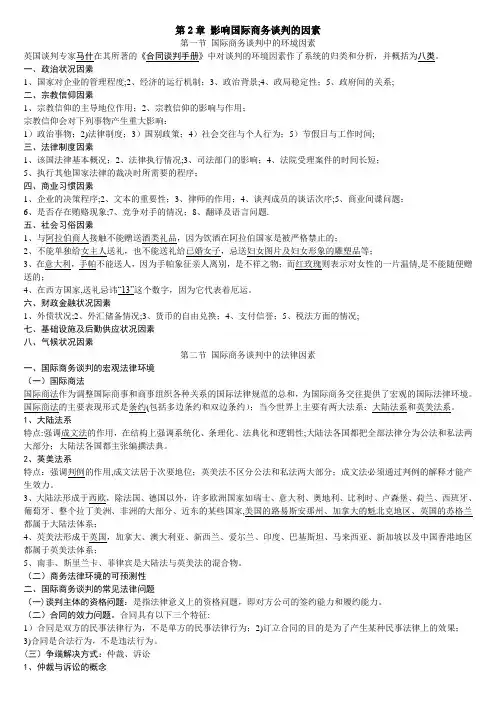
第2章影响国际商务谈判的因素第一节国际商务谈判中的环境因素英国谈判专家马什在其所著的《合同谈判手册》中对谈判的环境因素作了系统的归类和分析,并概括为八类。
一、政治状况因素1、国家对企业的管理程度;2、经济的运行机制;3、政治背景;4、政局稳定性;5、政府间的关系;二、宗教信仰因素1、宗教信仰的主导地位作用;2、宗教信仰的影响与作用;宗教信仰会对下列事物产生重大影响:1)政治事物;2)法律制度;3)国别政策;4)社会交往与个人行为;5)节假日与工作时间;三、法律制度因素1、该国法律基本概况;2、法律执行情况;3、司法部门的影响;4、法院受理案件的时间长短;5、执行其他国家法律的裁决时所需要的程序;四、商业习惯因素1、企业的决策程序;2、文本的重要性;3、律师的作用;4、谈判成员的谈话次序;5、商业间谍问题;6、是否存在贿赂现象;7、竞争对手的情况;8、翻译及语言问题.五、社会习俗因素1、与阿拉伯商人接触不能赠送酒类礼品,因为饮酒在阿拉伯国家是被严格禁止的;2、不能单独给女主人送礼,也不能送礼给已婚女子,忌送妇女图片及妇女形象的雕塑品等;3、在意大利,手帕不能送人,因为手帕象征亲人离别,是不祥之物;而红玫瑰则表示对女性的一片温情,是不能随便赠送的;4、在西方国家,送礼忌讳“13”这个数字,因为它代表着厄运。
六、财政金融状况因素1、外债状况;2、外汇储备情况;3、货币的自由兑换;4、支付信誉;5、税法方面的情况;七、基础设施及后勤供应状况因素八、气候状况因素第二节国际商务谈判中的法律因素一、国际商务谈判的宏观法律环境(一)国际商法国际商法作为调整国际商事和商事组织各种关系的国际法律规范的总和,为国际商务交往提供了宏观的国际法律环境。
国际商法的主要表现形式是条约(包括多边条约和双边条约);当今世界上主要有两大法系:大陆法系和英美法系。
1、大陆法系特点:强调成文法的作用,在结构上强调系统化、条理化、法典化和逻辑性;大陆法各国都把全部法律分为公法和私法两大部分;大陆法各国都主张编撰法典。
商务谈判整理资料(湖经法商专科专用)
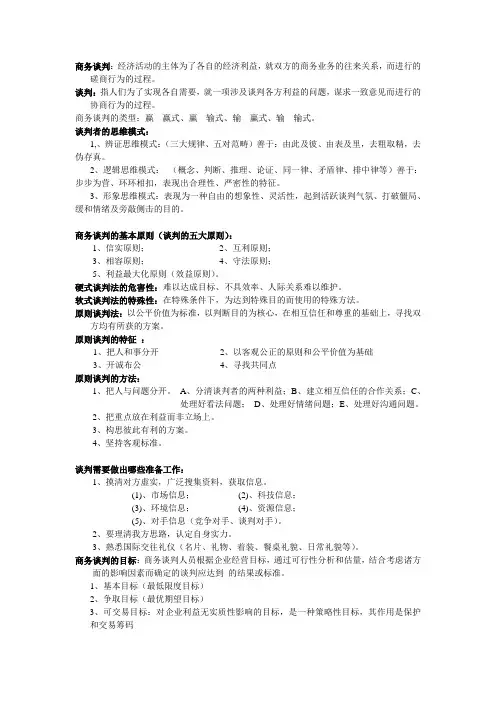
商务谈判:经济活动的主体为了各自的经济利益,就双方的商务业务的往来关系,而进行的磋商行为的过程。
谈判:指人们为了实现各自需要,就一项涉及谈判各方利益的问题,谋求一致意见而进行的协商行为的过程。
商务谈判的类型:赢---赢式、赢---输式、输---赢式、输---输式。
谈判者的思维模式:1,、辨证思维模式:(三大规律、五对范畴)善于:由此及彼、由表及里,去粗取精,去伪存真。
2、逻辑思维模式:(概念、判断、推理、论证、同一律、矛盾律、排中律等)善于:步步为营、环环相扣,表现出合理性、严密性的特征。
3、形象思维模式:表现为一种自由的想象性、灵活性,起到活跃谈判气氛、打破僵局、缓和情绪及旁敲侧击的目的。
商务谈判的基本原则(谈判的五大原则):1、信实原则;2、互利原则;3、相容原则;4、守法原则;5、利益最大化原则(效益原则)。
硬式谈判法的危害性:难以达成目标、不具效率、人际关系难以维护。
软式谈判法的特殊性:在特殊条件下,为达到特殊目的而使用的特殊方法。
原则谈判法:以公平价值为标准,以判断目的为核心,在相互信任和尊重的基础上,寻找双方均有所获的方案。
原则谈判的特征:1、把人和事分开2、以客观公正的原则和公平价值为基础3、开诚布公4、寻找共同点原则谈判的方法:1、把人与问题分开。
A、分清谈判者的两种利益;B、建立相互信任的合作关系;C、处理好看法问题;D、处理好情绪问题;E、处理好沟通问题。
2、把重点放在利益而非立场上。
3、构思彼此有利的方案。
4、坚持客观标准。
谈判需要做出哪些准备工作:1、摸清对方虚实,广泛搜集资料,获取信息。
(1)、市场信息;(2)、科技信息;(3)、环境信息;(4)、资源信息;(5)、对手信息(竞争对手、谈判对手)。
2、要理清我方思路,认定自身实力。
3、熟悉国际交往礼仪(名片、礼物、着装、餐桌礼貌、日常礼貌等)。
商务谈判的目标:商务谈判人员根据企业经营目标,通过可行性分析和估量,结合考虑诸方面的影响因素而确定的谈判应达到的结果或标准。
商务谈判复习资料整理重点(5篇)[修改版]
![商务谈判复习资料整理重点(5篇)[修改版]](https://uimg.taocdn.com/d7e66bd6aaea998fcd220e2b.webp)
第一篇:商务谈判复习资料整理重点商务谈判复习资料整理第一章:1基本需求理论:既要满足法人的需求,又要满足谈判者个人的需求。
(两种需求同时起作用,后者在中国的作用更加明显。
)2价格谈判法则:P——Q——S——D——P买方:P:100?(语气疑问),看不出有什么亮点啊!Q:质量不好,款式;外形;工艺;大小;颜色(各方面上找瑕疵);S:买了以后服务怎么样啊?(保修期才一年啊等问题);D:有没有其他方面的优惠呢(没有啊,那我觉得就有点不是很划算了);卖方:P:顾客问价格,先不回答价格,或者只是简单的说;S:售前售中售后服务方面;D:赠品,积分,其他优惠活动;(如果买不了,表示很遗憾;如果这次不行,表示下次再给其优惠)。
总之是围绕价格,捍卫自己的价格,即迂回政策。
常见的题型:如何站在买方或卖方的角度运用价格谈判法则将产品买入或者卖出,说服对方接受价格。
3提高谈判实力的策略:知己知彼,含而不露,合理造势,感情投入,多听少说,坚持原则,缓慢止步,若即若离,刚柔相济,谋求共赢。
4原则谈判法:A将人与问题分开,对事不对人;B谈判重点放在利益上,而非是立场上;C尽量构思双赢的方案;D根据价值和公平的标准去达成协议。
5商务谈判的基本原则:A合法守归;B平等自愿;C诚信互谅;D原则灵活;E大局为重;F互利共赢;G利益至上。
6商务谈判概念:指当事人之间为了实现一定的经济目的,明确相互的权利与义务关系,而进行协商的行为与过程。
7商务谈判的基本特点:A以获得经济利益为目的;B手段:相互协商;C主体:不同利益代表;D内容:商务谈判;E目标:互利共赢;F谈判效益事先难以预计,受多种因素的影响第二章商务谈判的准备:1在国际商务谈判中译员的作用有哪些?A使主谈改错;B更好的察言观色,从容应对;C替主谈担责。
2确定己方谈判策略:三十六计、角色扮演法、互换角色法、反复演练法、提出问题需找对策。
角色扮演法:事先我方组织两支谈判队伍模拟谈判。
商务谈判重点总结(合集5篇)
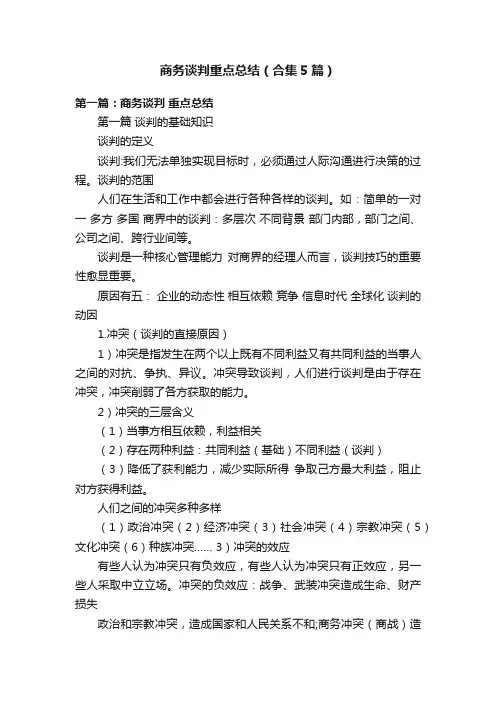
商务谈判重点总结(合集5篇)第一篇:商务谈判重点总结第一篇谈判的基础知识谈判的定义谈判:我们无法单独实现目标时,必须通过人际沟通进行决策的过程。
谈判的范围人们在生活和工作中都会进行各种各样的谈判。
如:简单的一对一多方多国商界中的谈判:多层次不同背景部门内部,部门之间、公司之间、跨行业间等。
谈判是一种核心管理能力对商界的经理人而言,谈判技巧的重要性愈显重要。
原因有五:企业的动态性相互依赖竞争信息时代全球化谈判的动因1.冲突(谈判的直接原因)1)冲突是指发生在两个以上既有不同利益又有共同利益的当事人之间的对抗、争执、异议。
冲突导致谈判,人们进行谈判是由于存在冲突,冲突削弱了各方获取的能力。
2)冲突的三层含义(1)当事方相互依赖,利益相关(2)存在两种利益:共同利益(基础)不同利益(谈判)(3)降低了获利能力,减少实际所得争取己方最大利益,阻止对方获得利益。
人们之间的冲突多种多样(1)政治冲突(2)经济冲突(3)社会冲突(4)宗教冲突(5)文化冲突(6)种族冲突…… 3)冲突的效应有些人认为冲突只有负效应,有些人认为冲突只有正效应,另一些人采取中立立场。
冲突的负效应:战争、武装冲突造成生命、财产损失政治和宗教冲突,造成国家和人民关系不和;商务冲突(商战)造成企业倒闭、工人失业冲突的正效应:激发发明创造促进社会进步促进人类发展4)控制和处理冲突(人们如何控制冲突呢?)处理不同意见战胜困难消除紧张局面,缓解压力。
2.利益得失指的是通过谈判可以获得的利益或者失去的利益,可以引发的成本或避免的成本。
1.2.3 Scarcity 资源的稀缺性利益得失的对抗源自于资源的稀缺性,稀缺性导致人类为争夺资源冲突不断。
3.谈判中的陷阱(失误)1)该赚的钱丢在了谈判桌上(也称为“双输谈判”)2)盈利太少3)从谈判桌边走开(拒绝对方的条款)4)满足于非最佳条款(也称为“同意偏好”)1.3.2 人们为什么是低效的谈判者1)自我中心主义,即以某一种自我吹嘘或自我满足的方式来看待自己的经验。
商务谈判高手个人简历模板
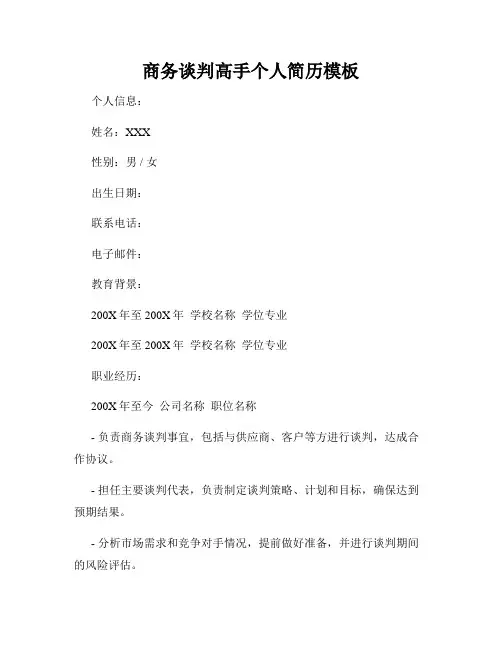
商务谈判高手个人简历模板个人信息:姓名:XXX性别:男 / 女出生日期:联系电话:电子邮件:教育背景:200X年至200X年学校名称学位专业200X年至200X年学校名称学位专业职业经历:200X年至今公司名称职位名称- 负责商务谈判事宜,包括与供应商、客户等方进行谈判,达成合作协议。
- 担任主要谈判代表,负责制定谈判策略、计划和目标,确保达到预期结果。
- 分析市场需求和竞争对手情况,提前做好准备,并进行谈判期间的风险评估。
- 与内部团队紧密合作,协调资源,确保谈判过程顺利进行。
- 处理谈判过程中的各类问题和争议,寻找解决方案,并保持良好的谈判氛围。
技能专长:1. 出色的沟通能力:具备良好的口头表达和书面沟通能力,能够清晰表达观点和意图,并能够有效倾听和理解他人。
2. 谈判技巧:熟悉并掌握各类谈判技巧,能够在不同的情况下灵活运用,达成双方满意的协议。
3. 分析能力:善于分析市场和竞争对手情况,全面评估谈判风险并制定相应策略。
4. 决策能力:能够在压力下快速做出决策,并对决策结果负责。
5. 团队合作:具备良好的团队合作精神,能够与内部团队紧密配合,共同达成目标。
荣誉奖项:- 200X年荣获XXX奖项- 200X年荣获XXX奖项自我评价:作为一名商务谈判高手,我具备优秀的谈判技巧和良好的沟通能力。
我熟悉各类商务谈判的流程和技巧,并能够根据具体情况制定相应的谈判策略。
我注重团队合作,善于协调资源,保持积极的谈判态度。
通过多年的实践经验,我积累了丰富的商务谈判经验,并在多个项目中取得了良好的谈判成果。
我相信我的技能和经验将能够在未来的商务谈判中取得更好的成果。
参考资料:无。
(完整word版)商务谈判复习资料
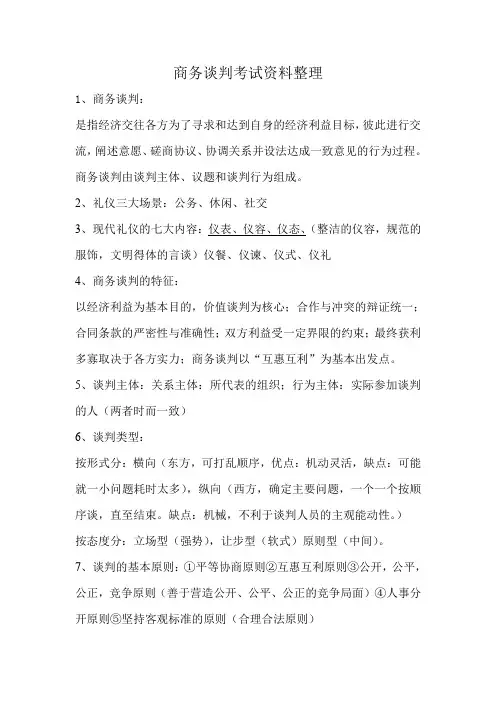
商务谈判考试资料整理1、商务谈判:是指经济交往各方为了寻求和达到自身的经济利益目标,彼此进行交流,阐述意愿、磋商协议、协调关系并设法达成一致意见的行为过程。
商务谈判由谈判主体、议题和谈判行为组成。
2、礼仪三大场景:公务、休闲、社交3、现代礼仪的七大内容:仪表、仪容、仪态、(整洁的仪容,规范的服饰,文明得体的言谈)仪餐、仪谏、仪式、仪礼4、商务谈判的特征:以经济利益为基本目的,价值谈判为核心;合作与冲突的辩证统一;合同条款的严密性与准确性;双方利益受一定界限的约束;最终获利多寡取决于各方实力;商务谈判以“互惠互利”为基本出发点。
5、谈判主体:关系主体:所代表的组织;行为主体:实际参加谈判的人(两者时而一致)6、谈判类型:按形式分:横向(东方,可打乱顺序,优点:机动灵活,缺点:可能就一小问题耗时太多),纵向(西方,确定主要问题,一个一个按顺序谈,直至结束。
缺点:机械,不利于谈判人员的主观能动性。
)按态度分:立场型(强势),让步型(软式)原则型(中间)。
7、谈判的基本原则:①平等协商原则②互惠互利原则③公开,公平,公正,竞争原则(善于营造公开、公平、公正的竞争局面)④人事分开原则⑤坚持客观标准的原则(合理合法原则)8、商务谈判成功的标志:①达到目标②建立和改善关系③富有成效9、商务谈判人员的综合素质:基本素质:政治素质、业务素质与心理素质+综合的能力培养成功的谈判者谈判的行为主体:坚强的思想素质,健全的心理素质,合理的学识结构,综合的能力素养,健康的身体素质,良好的仪态素质,丰富的谈判经验。
谈判高手的12项基本才能:机智,策略,审慎性,交际能力,知识,记忆,勇气,魅力,心理透视,公关口才,守口如瓶,耐性。
10、商务谈判人员的确定:①规模要适当:一名首席代表,三名主谈人及其他人员,由4-8人组成。
②知识能力要互补:主谈人员:谈判经验、领导协调能力。
其他人员由商务、技术、法律、财务、记录、观察、翻译等组成。
《商务谈判》复习资料
《商务谈判》复习资料(03874)目录第一章商务谈判导论 (2)第二章商务谈判原理 (7)第三章商务谈判方法 (12)第四章商务谈判内容 (15)第五章商务谈判准备 (25)第六章商务谈判的程序 (33)第七章商务谈判策略 (40)第八章商务谈判技巧 (46)第九章商务谈判素质 (53)第十章商务谈判礼仪 (58)第十一章商务谈判管理 (64)客观题 (66)第一章商务谈判导论第一节商务谈判的特征<考*点>1、商务:是人们在市场上从事的一切有形资产和无形资产交换或买卖活动的泛指或总称。
2、谈判:是人们为了协调彼此之间的关系,满足各自的需要,通过协商二争取达成意见一致的行为和过程。
3、商务谈判:就是在各种商务活动中,人们为了协调彼此的关系,满足各自的需求,在一定的时间空间条件下,通过协商对话以争取达成意见一致的行为与过程。
4、商务谈判的内涵:商务谈判是建立在人们彼此经济需要的基础上的;商务谈判是两方以上的交际行为;商务谈判是寻求建立或改善人们的经济关系;商务谈判是一种协调行为的过程;商务谈判的各方要接触就要选择恰当的时间和地点。
5、商务谈判的特征:商务谈判作为谈判行为的一种常见方式,不仅具有目的性、相互性和协商性等谈判的共性,还具有以下个性特征——商务谈判是以经济利益为目的,是物质利益关系的特殊表现,具有利益性;商务谈判是在遵循价值规律的基础上进行的,以价格为谈判的核心;商务谈判是促进商品经济发展的工具;商务谈判受到多种因素的影响;以经济效益作为商务谈判的主要评价指标。
第二节商务谈判的分类<考*点>6、商务谈判的分类:1)根据参加谈判的人数规模,分为个体谈判和集体谈判。
2)根据参加谈判的利益主体的数量,分为双边谈判和多边谈判。
3)根据谈判双方接触的方式,分为口头谈判和书面谈判4)根据谈判的事项(所涉及的经济活动)分为投资谈判、商品(劳务)贸易谈判、技术贸易谈判、租赁、承包谈判等5)根据谈判者所在地区范围为标志分类,分为国内商务谈判和国际商务谈判。
商务谈判资料整理
商务谈判—指买卖双方为了促进买卖成交,或是为了解决交易争议或争端,取得各自经济利益的一种磋商活动。
具有以下几个特征:1.普遍性:当事方和内容2.交易性:谈判标的的多样化3.利益性:追求实现经济利益为目的,以价格为核心4.协商性:有解决问题和分歧的愿望5.博弈性:谈判者收集信息、研究对方、运用策略和技巧以达目的商务谈判要素商务谈判主体:指从事商务谈判的人或组织商务谈判关系主体商务谈判行为主体商务谈判客体:指谈判标的和双方共同关心并希望解决的问题商务谈判目标:直接目标(最终达成协议)、具体目标(价格等)商务谈判背景:谈判所处的客观条件,有宏观和微观商务谈判的类型1.按谈判的态度分类软式谈判:建议-做让步-达协议-维持关系硬式谈判:Eg:撒切尔夫人在欧共体要求减少英国的负担原则式谈判:Eg:明星与制片商就付酬问题的谈判2.按谈判的方式分类纵向谈判:逐个讨论、逐个解决、直到结束横向谈判:确定主要问题,在逐个讨论,如遇分歧搁着后谈3.按谈判所在地分类主场谈判客场谈判中立地点谈判4.按谈判的沟通方式分类口头谈判书面谈判5.按参加谈判的人数分类单人谈判团队谈判商务谈判的内容合同之外的商务谈判时间、地点、议程、其他事宜合同之内的商务谈判价格、交易条件、合同条款商务谈判的过程收集信息制订洽谈计划建立洽谈关系达成洽谈协议履行洽谈协议维持良好关系商务谈判理论1.谈判需要理论PS.马斯渃需求原理生理需求—安全需求—爱和归属感需求—尊重需求—自我实现需求2.谈判博弈理论(Game Theory)3.谈判公平理论4.谈判黑箱理论对手谈判意图与谋略“难以捉摸”。
“黑箱”—“灰箱”—“白箱”5.谈判信息理论6.谈判期望理论激励力量=效价*期望商务谈判原则合法原则诚信原则平等协商原则求同存异原则互惠互利原则双方利益最大化原则商务谈判成败标准目标实现标准为首要标准成本优化标准基本成本(让步所产生的收益差距)+直接成本(各种资源)+机会成本人际关系标准要重视改善和加强双方友好的合作关系调研商务谈判环境1 收集谈判对手信息2 收集竞争对手信息3 收集市场信息4 收集自己企业信息5 收集相关环境信息商务谈判环境调查内容1.宏观环境(1)政治环境:体制、政策、国家(地方)政局、法律、法规、消费权益等,关系到谈判经济环境项目的风险、合法性、履行的结果和权益的保护。
商务谈判复习资料
商务谈判复习资料商务谈判是商业活动中不可或缺的一环,它是商业合作的基础。
无论是合作伙伴之间的谈判,还是采购商与供应商之间的谈判,都需要遵循一定的谈判原则和技巧。
下面的内容将为您提供一份商务谈判复习资料,帮助您更好地准备商务谈判。
一、准备阶段1.了解谈判对象:在商务谈判前,我们应该了解与我们进行谈判的对象,包括他们的背景、需求、限制条件等。
这些信息将有助于我们制定合适的交易方案。
2.制定交易方案:在了解谈判对象后,我们需要制定一个合适的交易方案。
这个方案应该集合我们的目标、对方的需求以及我们面临的限制等因素。
3.准备谈判策略:在制定交易方案的基础上,我们应该构思一系列的谈判策略,包括最低限度的条件、备选方案和谈判技巧等,以帮助我们在谈判中获得更好的结果。
二、谈判过程1.切入谈判话题:在谈判开始时,我们应该尽早地表明我们的立场和目标,并与对方商讨共同点和差异。
2.运用有效的谈判技巧:在谈判中,我们应该运用各种有效的谈判技巧,例如追问技巧、沉默技巧和威胁技巧等,以达到谈判的目的。
3.正确处理分歧:在谈判过程中,难免会出现分歧。
我们需要学习如何正确处理这些分歧,寻找新的解决方案,试图达成双方都能接受的交易。
三、结束阶段1.达成双赢的结果:最终的目标是寻求一种双方都能接受的结果。
在谈判结束前,我们应该确保双方都已达成协议,并且将结果书面化。
2.整理谈判备忘录:在商务谈判结束后,我们应该整理一个谈判备忘录,详细描述项目的必要条件、达成的协议以及合作计划等,以帮助我们在未来的合作中更好地运作。
商务谈判是一门艺术,需要不断学习和实践。
只有通过不断地实践和总结,我们才能在商务谈判中获得更好的结果。
希望以上资料能帮助您在商务谈判中更加游刃有余。
国际商务谈判复习资料
国际商务谈判复习资料Part zero1、definition of negotiationNegotiation is a dialogue intended to resolve disputes, to produce an agreement upon courses of action, to bargain for individual or collective advantage, or to craft outcomes to satisfy various interests.A negotiation is a process of communication between parties to manage conflicts in order for them to come to an agreement, solve a problem or make arrangements.2、business negotiation1)definition:It is a process in which the participants of business activities communicate, discuss, and adjust their views, settle differences and finally reach a mutually acceptable agreement in order to close a deal or achieve a proposed financial goal.2)Characteristics :The objective of business negotiation is to obtain financial interestThe core of business negotiation is priceIts principle is equality and mutual benefitItems of contract should keep strictly accurate and rigorous3、international business negotiation1)definition:It refers to the business negotiation that takes place between the interests groups from different countries or regions. It is an important activity frequently involved in foreign trade and other economic exchange, serving a critical approach and method for these interest groups or individuals to confer together to reach an agreement or settle the issues of their interest conflicts.2)Characteristics :In addition to the general characteristics of typical business negotiations, international business negotiation demonstrated the following features: The difficulty and the cost are greater than that of domestic businessLanguage barriersCultural differenceInternational laws and domestic laws are both in forceInternational political factors must be taken into account3)FormsClassified by forms: ①one-to-one negotiation ②multilateral negotiationClassified by negotiation site: ①Host venue ②Guest venue ③The third party’s venueClassified by attitudes of two parties:①Soft negotiation ②Hard negotiation ③Principled negotiationClassified by ways of communication: ①Oral negotiation ②Written negotiation Classified by negotiation object:①Product trade negotiation ②Technology trade negotiation ③Service trade negotiationClassified by the order of negotiators discuss problems:①Horizontal Negotiation ②Vertical negotiation4)PrinciplesEquality and mutual benefit principleKeep it flexible and fluidSincere cooperationAct in strict accordance with the lawPartⅠ4、Maslow's hierarchy of needsMaslow's hierarchy of needs is often portrayed in the shape of a pyramid, with the largest and most fundamental levels of needs at the bottom, and the need for self-actualization at the top. Maslow’s theory suggests that the most basic level of needs must be met before the individual will strongly desire the secondary or higher levels needs.In negotiation, how to use the need theory to find, analyze and satisfy each other’s needs is very crucial for any negotiator to gain over the most possible benefits.1)Survival needs and negotiationThe survival needs are embodied in the negotiation as the negotiator’s needs or dress, food, accommodation, and traveling. As a host and negotiating organizer oneshould provide for the other party a better living condition to lighten the inconveniences, the psychological pressures and the doubtful feelings of the guest negotiators, which is helpful for creating a friendly negotiating atmosphere.2)Security needs and negotiationThe negotiator’s security needs are mainly that of personal, positional and economical benefits.The guest negotiator is not familiar with the local social situation, customs and public order and traffic. They may feel a lack of security or safety. So the host should try to give more considerations to every detail of safety issues.Status security represents that both parties will probably regard reaching an agreement as his task. The negotiator should have a correct understanding of negotiation on an equal basis and for mutual benefit. A negotiator’s work should not be evaluated by the standard of reaching an agreement.The negotiator’s superiors are likely to link the negotiation result with the negotiator’s income. Sometimes the negotiator may take the risk of seeking his personal benefit by reaching an agreement at the cost of the interests of the country or organization.3)Social needs and negotiationEvery negotiator hopes to establish friendly relationship with the other party. In addition, they also hope to have a solidary team of their own to get a successful negotiation result. Therefore negotiators should understand each other andself-surrender a bit to satisfy their own social needs.4)Ego needs and negotiationOne’s need for respect is from three different sources: He needs the respect of his colleagues back home which isfundamental to his personal satisfaction from the negotiation. He will be influenced by the respect of the other party and believe that the other party’s respect depends on his success in earning those material goods. He will also be concerned with his self-respect which will equally focus on his success in winning material goods.In a negotiation if both parties can satisfy each other’s needs for respect, then this respect will change into a power to restrict each other’s behavior and ensure a successful negotiation.5)Self-actualization needs and negotiationThe satisfaction of the self-realization needs in negotiation depends on the achievement the negotiator has made. The more benefits you obtained, the higher degree of satisfaction you’ll have of self-realization needs. To evaluate the negotiator, it is not enough to observe the benefits he strives for. Under what condition and how he strives for the benefits should also be taken into consideration.Negotiators should learn to use the Maslow Need Theory Model as a situational thermostat. Judging how the other person reacts to offers or proposals will reveal how close to making the deal too painful for the other person to accept.5、Game TheorySince both "rationally" decide to defect, each receives a lower reward than if both were to stay quiet. Traditional game theory results in both players being worse off than if each chose to lessen the sentence of his accomplice at the cost of spending more time in jail himself.We must remember the golden rule when it comes to business competition, as taught by the prisoner’s dilemma: Acting in one’s self interest does not always serve one’s self interest.By analysing the top-scoring strategies, Axelrod stated several conditions necessary for a strategy to be successful.1)NiceThe most important condition is that the strategy must be "nice", that is, it will not defect before its opponent does. Almost all of the top-scoring strategies were nice; therefore, a purely selfish strategy will not "cheat" on its opponent, for purely self-interested reasons first.2)RetaliatingHowever, the successful strategy must not be a blind optimist. It must sometimes retaliate. An example of a non-retaliating strategy is Always Cooperate. This is a very bad choice, as "nasty" strategies will ruthlessly exploit such players.3)ForgivingSuccessful strategies must also be forgiving. Though players will retaliate, they will once again fall back to cooperating if the opponent does not continue to defect. This stops long runs of revenge and counter-revenge, maximizing points.4)Non-enviousThe last quality is being non-envious, that is not striving to score more than the opponent.6、Principled negotiationPrincipled negotiation is the name given to the interest-based approach to negotiation set out in the best-known conflict resolution book, Getting to Yes. The book advocates four fundamental principles of negotiation:1) separate the people from the problem;Separating the people from the problem means separating relationship issues from substantive issues, and dealing with them independently. People problems often involve difficult emotions — fear, anger, distrust and anxiety for example. These emotions get intertwined with the substantive issues in the dispute and make both harder to deal with.2) focus on interests, not positions;Negotiating about interests means negotiating about things that people really want and need, not what they say that want or need. Often, these are not the same. People tend to take extreme positions that are designed to counter their opponents’positions. If asked why they are taking that position, it often turns out that the underlying reasons--their true interests and needs--are actually compatible, not mutually exclusive.3) invent options for mutual gain;By focusing on interests, disputing parties can more easily fulfill the third principle--invent options for mutual gain. This means negotiators should look for new solutions to the problem that will allow both sides to win, not just fight over the original positions which assume that for one side to win, the other side must lose.4) introduce on objective criteria.If union and management are struggling over a contract, they can look to see what other similar companies have agreed to use as an outside objective criteria. This gives both sides more guidance as to what is "fair," and makes it hard to oppose offers in this range.The four components are interrelated with each other and should be applied to throughout the whole course of the negotiations.Part Ⅱ7、Setting up an AppointmentPersonal Styles VS Degree of AC(个性类型与谈判模式)1)Competing style of persons tends to use high pressure and they force the other party to surrender to their demands.2)Collaborating style of persons show concerns and understanding to parties’interests, difficulties and satisfactions, trust others and offer help needed in negotiation.3)Compromising style of persons try to split the difference or find an intermediate point according to some principle.4)Avoiding style of persons is never willing to cooperate with others nor do they state their consent or objection openly.5)Accommodating style of persons habitually accept others’ desires and requests. The model clearly shows the position ofeach personal style in the graph and their combination of different degrees of assertiveness and cooperativeness.1)Competing style and accommodating style are at the high ends of assertiveness and cooperativeness.2)Avoiding style is neither assertive nor cooperative, thus is the least recommended style for negotiations.3)Compromising style, corresponding its middle position, is inclined to take middle way and seeks balance between different people.4)Collaborating style combines highest degree of both assertiveness and cooperativeness and should be recommended as the most suitable personal style for negotiations.By cooperating with different kinds of counterparts, you can adopt different strategies accordingly.8、Negotiation StrategiesYour case and bargaining position will determine which negotiation strategy will work best for you:Competitive, when you must have what you want;Accommodation, when you have done wrong and want to settle quickly; Compromising, when expedience matters most; Collaborative, when you want to create a bigger pie;Avoidance, when you are not yet ready to bargain.The Competitive Strategy——“I win, you lose” is the one most often used in settlement negotiation. Following are examples of some competitive tactics: 1) Alternatives to settlement.Emphasize you have better choices than settlement.2) “Anything but that”Claim your adversary’s offer is not enough, even when it is.3) Bluffing(欺骗,糊弄)Bluffing is at negotiation’s core because each side has limited information. Look for signs of uncertainty on adversary’s face or in his body language. Uses the uncertainty to create even more doubt. And doubt translates into risk, and risk into money. 4) Bringing in the mediaThreaten to report some action or behavior to the media to induce concessions. (media-sensitive industries)5) Creating deadlockCreate deadlock to force your adversary into concessions to move the negotiations along.6) Diversion/DistractionIf you feel you are losing an important issue, shift the discussions to a different issue before you concede(让步).7) Done dealTake some unilateral(单边的) action and present it to other side as a “done deal”. Your adversary is thus forced to acquiesce(勉强同意) or walk out.8) Good cop/Bad copTeam an aggressive negotiator with a friendly negotiator to win concessions. The aggressive negotiator uses competitive tactics to anger and distract your adversary. The friendly negotiator steps in to smooth things over. You can strike a deal on thefriendly negotiator’s terms.9) Irrational behaviorSometimes act irrationally, not only to distract and unnerve, but also to undermine your adversary’s confidence.10) Limited authorityClaim to lack authority to settle at some amount and ask your adversary to reduce the offer to your authority limits.11) Limited timeConstrain the time limits of the negotiation.12) “Poor me”Act like you have no background or training in negotiation and ask your adversary’s help. He may sympathize with you and be more reasonable than he intended.13) SilenceVery few people can endure silence. Silence can impel your adversary to give you more information or concede more than he intended.14) Straw manDemand agreement on issue 1, which your adversary cares about most. Create deadlock and then “reluctantly” concede issue 1 to gain agreement on issue 2.15) TurnaboutAfter you have conceded an issue or otherwise acted defensively, “gain space”by coming out strong on the next issue.16) Use of powerThreaten to use your power and sometimes actually use it.●The Accommodation Strategy——An accommodating party will sublimate itsconcerns to satisfy the other party’s, at least for the present. You choose an Accommodation Strategy if you have done wrong and want to get the matter over with quickly and less expensively.1) Face-savingPrioritize the other side’s dignity. Allow the other side to make tactful retreats to avoid embarrassment.2) IdentificationAlign your interests with your adversary’s, see the facts from her perspective, and agree with her arguments. But don’t concede unnecessary issues.3 )Take the lead oarMove the negotiation forward regardless of who created the difficulty.4) Take reasonable actionsAlways be the party of reason, whether setting realistic deadlines or other conditions of the negotiation.●The Compromising Strategy——Compromisers look for an expedient, partiallysatisfactory middle ground.1) Bit-by-bitGain your concessions “bit-by-bit” rather than all at once.2) Conditional proposalsMake a proposal conditioned upon your adversary’s acceptance of issues you need favorably resolved.3) “Log-rolling”Concede on an unimportant issue to you in exchange for your adversary’s concession on an issue that does matter to you. 4) “Splitting the baby”At some point offer to split the difference with the other side5) Tit-for-tat针锋相对Never make a concession without obtaining one in return.●The Collaborative Strategy——The Collaborative Strategy(win-win)seeks tocreate value for both sides. Its focus is on each side’s underlying interests and not their positions.1) FlexibilityBe flexible. Know when to mount a tactical retreat and when to press for an important point.2) Focus on processProcess often translates into improved substance.3) Identify with others in similar circumstancesArgue that the other side has already treated similarly-situated X in a particular way, and they should treat you the same way.●The Avoidance Strategy——Avoiders try to ignore the entire dispute, or somespecific issues, for at least some period of time.1) Negotiate money issues firstIf you prioritize money, insist that money be negotiated first.2) Negotiate non-money issues firstIf you wish to avoid paying money, address the non-money issues first. You can then value your none-monetary concessions and use those values to reduce the amount of money you will pay your adversary.3) Refuse to combine negotiation of related disputesIf you are litigating multiple related actions, refuse to negotiate the actions together if you determine that you are stronger in one case than another.4) Walk out of the negotiationIf you become engaged in negotiations you are not ready for, walk out.5) Withdraw an issueIf you are not yet ready to address an issue, perhaps because it is too painful or simply not ripe for discussion, remove that issue from the negotiation, for at least some period of time.6) Switching strategiesYou may decide to switch strategies if you feel you are making insufficientprogress.Part Ⅲ9、Free trade areaWTO means the World Trade OrganizationGATS means the General Agreement on Trade in Services, which is part of the WTO Agreement;GATT means the General Agreement on Tariffs and Trade, which is part of the WTO Agreement.FTA(free-trade area)is a theoretical concept where a trade bloc whose member countries have signed a free-trade agreement (FTA), which eliminates tariffs, import quotas, and preferences on most (if not all) goods and services traded between them.中⽇韩⾃由贸易区CJK FTA1)General Trade and Economic Relations among the Three Countries China, Japan and Korea are major economic playersin the world which recorded nearly 20% of the world’s total GDP. The share of intra-regional trade among the three countries has increased steadily. China was the largest trading partner of Japan and Korea, and the two countries were regarded as the second and third largest trading partners of China.However, intra-regional trade levels were still much lower than those of the EU and NAFTA, substantial economic integration has not yet evolved in this region. Given the region’s economic power and competitiveness, economic integration in the region will certainly bring tremendous benefits not only to the region, but also to the world.2) Impacts of a Future CJK FTA on Agriculture, FisheryA possible CJK FTA will bring the three countries potential benefits, including access for consumers to a wider range of agricultural products with lower prices and improved access for exporters to the partners’ markets. However, it would raise concerns in Japan and Korea for serious impacts on domestic agriculture production. It also increase pressure for China to meet domestic demand and lost price advantage in agriculture due to the rapidly increasing labor and input cost. In pursuing a possible CJK FTA, due consideration should be given to sensitive products of each country.In the fishery sector, China is more competitive in fresh water fishery, while Japan and Korea are more competitive in marine capture fisheries. With a possible CJK FTA, trade in fish products would benefit consumers and improve the overall national welfare of the three countries. However, a decline of fishery resources, increasing cost of capturing and stronger competition from areas will attenuate the positive effect. So consideration should be given to the effect of an appropriatefishery resources management to ensure sustainable development of fishery industries.3) Impacts of a Future CJK FTA on Industrial GoodsA CJK FTA will likely increase the trade volumes and enhance production networks among them. On the other hand, a CJK FTA would reveal sensitive sectors in all three countries. For China, a CJK FTA could result in further accelerated increase of imports from Japan and Korea, thus bringing bigger pressure on China’s domestic enterprises in such sensitive industries as chemicals; automobiles; electronics and ship-building, etc.In order to enhance the competitiveness of the manufacturing industries of China, Japan and Korea, the three countries should not only reduce tariff andnon-tariff measures which have adverse effects to trade, but also deepen and strengthen economic linkages among the three countries to establish a win-win-win relationship through forming a CJK FTA, with due consideration to the sensitivities of each country in these areas.4) Impacts of a Future CJK FTA on Trade in servicesBy reducing barriers and enhancing transparency, a possible CJK FTA might contribute to and enhance the momentum of mutual cooperation, MA, movement of goods, capital, persons and technology and trade facilitation. A future CJK FTA will help bring down costs and prices, increase efficiency and innovation, and broaden the range of services being offered, thus improving the quality of services through maximization of cross-border resource allocation processes. The facilitation of movement of business personnel will also promote the overall development in the services sectors.5) Impacts of a Future CJK FTA on InvestmentWith a comprehensive CJK FTA, which focuses on enhancing market access by eliminating restrictions against foreign investment in an appropriate manner, more active trade and investment in Northeast Asia would ensue. Liberalization of investment would also enable investors to mobilize their resources for further development in this region, thus leading to a mutually beneficial cooperative partnership among the three countries in the future.In future negotiations on the investment chapter, more flexibility should be given to China for adaption and modification in its liberalization process.6) E-commerceWith the development of information technology, e-commerce has emerged as a dynamic form of transaction and one of the most quickly growing business industries in the world. Increasing use of e-commerce can bring economic growth and opportunity through facilitating trade in goods and introducing new services. Enterprises, including SMEs, will profit from the use of e-commerce as it improves efficiency and reduces the cost of transactions. A possible CJK FTA would provide an opportunity to enhance trilateral e-commerce cooperation and transaction.中国-东盟⾃由贸易区中国-新西兰⾃由贸易区Part Ⅳ10、Four modes of supply of the General Agreement on Trade in Services(GATS)1) Cross-border (跨境交付)——from the territory of one Member into the territory of any other Member.Mode 1: A user in country A receives services from abroad through its telecommunications or postal infrastructure.2) Consumption abroad(境外消费)——in the territory of one Member to the service consumer of any other Member. Mode 2: Nationals of A have moved abroad as tourists, students, or patients to consume the respective services.3) Commercial Presence(商业存在)——by a service supplier of one Member, through commercial presence, in the territory of any other Member.Mode 3: The service is provided within A by a locally-established affiliate, subsidiary, or representative office of a foreign-owned and — controlled company (bank, hotel group, construction company, etc.).4) Presence of natural persons(⾃然⼈流动)——d.by a service supplier of one Member, through the presence of natural persons of a Member in the territory of any other Member.Mode 4: A foreign national provides a service within A as an independent supplier (e.g., consultant, health worker) or employee of a service supplier (e.g. consultancy firm, hospital, construction company).。
- 1、下载文档前请自行甄别文档内容的完整性,平台不提供额外的编辑、内容补充、找答案等附加服务。
- 2、"仅部分预览"的文档,不可在线预览部分如存在完整性等问题,可反馈申请退款(可完整预览的文档不适用该条件!)。
- 3、如文档侵犯您的权益,请联系客服反馈,我们会尽快为您处理(人工客服工作时间:9:00-18:30)。
商务谈判的原则1兼顾双方利益的原则2公平的原则3信息原则4商务谈判中的心理活动原则5时间限制原则谈判的五个组成阶段1项目评估2制订谈判计划3建立信任关系4达成协议5协议执行语言沟通的基本原则得体,准确,委婉,通俗,简洁,礼貌。
开局策略:(1)协商式开局策略,即以协商、肯定的语言进行陈述,使对方对己方产生好感,创造一致的氛围。
从而使谈判双方在友好、愉快的气氛中展开谈判工作。
此策略比较适用于谈判双方实力接近,过去没有商务往来经历的谈判。
(2)一致式开局策略,即以对方熟悉的方式或喜爱的事物为切入点,创造一种和谐、融洽的谈判环境和气氛,把对方引入谈判中。
此策略在于显示我方对对方的尊重,在于显示我方的诚意。
(3)保留式开局策略,即在谈判开始时,对谈判对手提出的关键性问题不做出彻底的、确切的回答,而是有所保留,从而给对手造成神秘感,以吸引对手步入谈判。
(4)坦诚式开局策略,即以坦诚布公的方式向谈判对手陈述自己的观点或想法,从而为谈判打开局面。
(5)慎重式开局策略,即以严谨、凝重的语言进行陈述,表达出对谈判的高度重视和鲜明的态度,目的在于使对方放弃某些不适当的意图。
慎重式开局策略适用于谈判双方过去有过商务往来,但对方曾有过不太令人满意的表现,己方通过严谨、凝重的态度,引起对方对某些问题的重视。
(6)进攻式开局策略,即通过语言或行为来表达己方强硬的姿态,从而获得对方必要的尊重,并借以制造心理优势,使得谈判顺利地进行下去。
(7)挑剔式开局策略,即开局时,对对手的某项错误或礼仪失误严加指责,使其感到内疚,从而达到营造低调气氛、迫使对方让步的目的。
(8)先声夺人的开局策略,即谈判一方率先表明自己对谈判的态度、对交易的信心,或介绍自己的产品、本公司的实力等,把对方的思路引导到自己的轨道上,从而使整个谈判按自己的意图进行。
您一定要…..,否则的话我们就…..老板,大家交个朋友吧,尾款我就不要了,你桌上的戒指能不能给我?老板,如果你把桌上的戒指给我的话,我也许可以考虑不收尾款。
如果你买钻戒给我,我也许会考虑嫁给你。
我嫁给你,能不能考虑买个钻戒给我。
如果你订我们杂志一年,就送你这款精美的手表。
喜欢这款精美的手表吗?只要订我们杂志一年,这只表就是你的。
请问上面两种说法,你喜欢第一种说法,还是第二中说法?换和钓交货期可不以提前?当然不行了,不过看在两家公司过去合作还是愉快的份上,勉为其难答应你这一次。
王先生,既然你找到我们公司,我们一定做到让你满意,毕竟让我们客户满意是我们服务的最高准则,但要是下次再有类似的状况我们就毕竟为难了。
Yes….but no….but语言沟通的表达方式1.委婉表达有些不宜直接说出来的话,需采取委婉、含蓄的表达方式,因委婉表达能有效地融和紧张的谈判气势,打破僵局。
摆脱窘迫、尴尬的局面和避免矛盾。
它并不意味着说话音调和态度的软弱。
(1)善用温和的言辞(2)善用感情移入法(3)善于用提供“台阶”给他人“留面子”,如将“贵方的产品质量低劣”变换为“贵方的产品质量,我们心中有数”。
你们的报价这么高,我们怎么能接受?你们的报价高的出乎我们的意料,有商量的余地吗?2 模糊表达模糊表达不仅能改善谈判气氛,使谈判能顺利地进行,还能试探出对方的真正意图和问题所在,寻求和扩大共同点,以期达到最后的共识。
不给出肯定的回答或留有余地。
(1)善用形容词、副词(2)回避直言,如“因为大家所不知道的原因,我们两家单位曾经一度中断联系10年。
”⏹如果你们都已经准备就绪了,我们可以在较短的时间内开始工程设计。
⏹我们可以考虑你们刚才提出的建议。
⏹我们或许可以按刚才的计划实施。
⏹我们会选择比较好的方法来达到你们的要求。
⏹我们会尽量满足你们的要求,尽快发货的。
3.得体表达谈判双方常喜欢宣讲自己的优点、优势和所取得的成就等,往往过激,且咄咄逼人。
为此,谈判双方应遵循得体和礼貌的表达原则。
(1)少用感叹语气,如将“我们这种设备的性能真是好极啦!”变换为“根据用户反应,这是一种性能良好的设备。
”(2)避免华丽辞藻,如将“这种打火机性能良好,经久耐用。
”变换为“这种打火机可以连续操作4万次以上。
”模糊表达练习:史密斯:王先生,我想知道你方报盘。
王先生:好的,史密斯先生,我方一直替你留着该盘,80打羊毛套头衫,每打160美元。
史密斯:价格太高了,我们很难做开。
王先生:听你这么说,我感到吃惊。
你要知道,自去年以来,羊毛套头衫的价格上涨幅度很大,可我们的价格却无大的变动,相比而言,是很优惠的。
史密斯:对此,我恐怕难以同意你的说法。
日本入市价格就较低一些。
王先生:不过,经营此衫的商家应知道,中国的质量是上乘的。
从质量方面来考虑,我认为价格是很合理的。
史密斯:毫无疑问,贵方的产品质量是高,但现在市场竞争激烈,我知道有些国家在降价。
王先生:我方的产品是以质量取胜,有很少产品能在性价比上竞争过我方。
史密斯:但是要说服我的客户接受你们的价格是很难的。
王先生:坦率地说,如果不是鉴于我们的友好关系,我本来不考虑以此价来报实盘的。
史密斯:看来我别无选择,只好接受王先生:我很高兴我们能谈妥价格。
试从上述谈话中挑出模糊表达的词语得体表达练习:结合“得体表述”的要求,分折下列句子存在的缺点,并转换。
(1)我们这种设备的性能,真是好极了!(2) 我们企业发展速度快,海内外闻名,产品深受用户欢迎。
发问的方式:1、封闭式发问回答应是肯定答复“是”或“不是”2、开放式发问不限定答复的范围,对话者可畅所欲言3、澄清式发问让对方做出证实或补充。
4、探索式发问针对对方的答复,就原先的问题继续讨论5、借助式发问借第三者的意见以影响对方意见的提问6、引导性发问暗示对方,按发问方的设计来回答。
问句分类:请将下述问句依照“引导式、探索式、借助式、封闭式、开放式、澄清式”的标准归类。
(1)你的报价是怎样算出来的?(2)你同意这个价格吗?(3)你对我方的报价有何看法?(4)我们请教了某某顾问,贵方报价较高,请你考虑是否把价格再降一些?(5)在交货时,难道我们不考虑入境的问题?(6)我们负责运输,贵方在价格上是否再考虑考虑?(7)你是否认为“上门服务”没有可能?报价的策略1价格起点策略2除法报价策略3加法报价策略4差别报价5对比报价6数字陷阱保险公司为动员液化石油气用户参加保险,宣传说:参加液化气保险,每天只交保险费1元,若遇到事故,则可得到高达1万元的保险赔偿金。
文具商向画家推销一套笔墨纸砚。
他先报笔价,要价很低;成交后再谈墨价,要价也不高;待笔墨卖出之后,接着谈纸价和砚价,适当抬高价格。
画家已经买了笔和墨,自然想成套,不忍放弃纸和砚,也一并购买了。
你们公司已经购买了新设备,想把旧设备赶紧处理掉。
经理把这项任务交给了你,并告诉你卖120000元就可以了,第二天,你的朋友告诉你有人愿意出140000元购买,你将如何对待这件事?A、接受140000元的价格,并抓紧办理手续B、告诉对方一周以后再和他谈这件事,因为你现在很忙。
在此期间你自己联系新的买主C、马上跟对方讨价还价D、告诉对方有人出150000元,你们正在进行谈判。
如果他可以出更高一点的价格可以优先考虑美国著名发明家爱迪生在某公司当电气技师时,他的一能够项发明获得了专利。
公司经理向他表示愿意购买这项专利权,并问他要多少钱。
当时爱迪生想:只要能卖到5000美元就很不错了,但他没有说出来,只是说:“您一定知道我的这项发明专利权对公司的价值了,所以,价钱还是请您自己说一说吧。
”经理报价说:“40万元,怎么样?”一家中方公司代理销售派克笔。
谈判人员在和进货商谈判时诚恳地说:“一支钢笔100元看起来是贵了点,但也只相当于一包精装红塔山,一支笔可用四五年,可一包烟只能抽四五天。
少抽一包烟就可以买一只精致的笔,而且是名牌,在用的时候又显得很有风度,值得!您说呢?”讨价还价的技巧1不开先例技巧2先造势后还价3规定期限技巧4吹毛求疵技巧5先斩后奏技巧6疲惫技巧7投石问路技巧不开先例的技巧电冰箱进货商(甲方)和电冰箱供货商(乙方)就电冰箱价格进行谈判。
甲方:你们提出的每台1700元,确实让我们难以接受,如你们有诚意的话,能否每台降低300元?乙方:你们提出的要求是在令人为难,一年来我们给进货的600多位客户都是这个价格,要是这次单独破例给你们调价,以后与其他客户的生意就难做了。
很抱歉,我们每台1700元的价格不贵,不能再减价了。
巧妙答复技巧分析1、在答复您的问题之前,我想听听贵方的观点。
2、很抱歉,对您所提的问题.我并无第一手资料可作答复,您叫我怎么说呢….3、我们的价格是高了一点,但产品的关键部位使用了优质进口零件延长了产品的使用寿命。
4、贵公司的要求是可以理解的,但我们公司对价格一向采取铁腕政策,因此,实在无可奉告。
价格谈判的五个步骤1询价/报价2价格解释3价格分析4价格评论5讨价还价日本商人特点:以家族性企业为主民族观念和集体观念极强有团队精神很讲究礼貌说话有分寸富有耐心非常讲面子等级观念极强重视尊卑次序“小气”。
